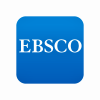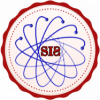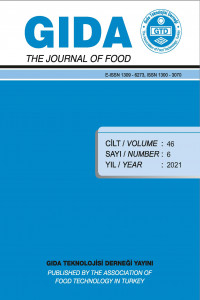Research Article
Issue Editorial Board




Yağ Bilimi ve Teknolojisi, Nanolifler, Emülgatörler, Kolloit sistemler, Tekstürel ve reolojik özellikler
Aim & Scope
GENERAL POLICY OF THE JOURNAL
"THE JOURNAL OF FOOD" is published for the Association of Food Technology-Turkey. The Editorial Mission of "THE JOURNAL OF FOOD" is to offer scientists, researchers, and other food professionals the opportunity to share knowledge of scientific advancements in the various fields of food science and technology, through a respected peer-reviewed publication.
This authoritative and well-established journal publishes papers in both English and Turkish in all fields of food science and technology, provided that they make a sufficient contribution to knowledge in these fields. Papers may cover original research in the various sciences associated with food, including new results obtained experimentally, descriptions of novel experimental methods that are important for food science and technology, or new interpretations of existing results. While the main target of the journal is to provide an international forum for original research and developments in food science and technology, review articles and notes (short concise communications) are also welcomed. Topics of only narrow local interest will not be accepted unless they have wider potential or consequences.
"THE JOURNAL OF FOOD" considers all manuscripts on the condition that they have been submitted only to "THE JOURNAL OF FOOD", that in whole or in part have not been published previously in any language other than as a thesis and an abstract of an oral or poster presentation, nor are they under consideration for publication or in press elsewhere, that their publication are approved by all authors, and that if accepted they will not be published elsewhere in the same form, without the written consent of the Association of Food Technology-Turkey.
"THE JOURNAL OF FOOD" will only accept manuscripts in which there is Evidence of the Ethical Use of animals or harmful substances. When reporting experiments on human subjects, authors should also indicate whether the procedures followed were in accordance with the ethical standards of the responsible committee on human experimentation and with the Helsinki Declaration (revised) of 1983.
It is the sole responsibility of authors to disclose any affiliation or involvement, either direct or indirect, with any organization with a financial interest in the subject matter or materials discussed in the manuscripts that may affect the conduct or reporting of the work submitted. Information about potential Conflict of Interest should be clearly stated on a separate page (cover page) at the time of submitting their manuscript. If deemed appropriate by the Editor, a general statement regarding disclosure will be included in the Acknowledgement.
There is no page charge for publication in "THE JOURNAL OF FOOD".
Please read the instructions below carefully for details on the submission and preparation of manuscripts, the journal's requirements as well as information concerning the procedure after a manuscript has been accepted for publication in "THE JOURNAL OF FOOD". Manuscripts will be rejected without peer review if they do not comply with the author instructions or are beyond the scope of the journal.
Author Guidelines
Review manuscripts in English are not acceptable.
"THE JOURNAL OF FOOD" AUTHOR INSTRUCTIONS
MANUSCRIPT SUBMISSION
Manuscripts should be submitted to https://dergipark.org.tr/gida.
Responsibility for the accuracy of the manuscript content, lies entirely with the authors.
Editorial Office: e-mail: dergi@gidadernegi.org
Authors are invited to suggest three reviewers with names, addresses, telephone and fax numbers and e-mails, on a separate page (cover page) at the time of submitting their manuscript but Editors reserve the right to select reviewers of their choice.
"THE JOURNAL OF FOOD" has a severe policy of manuscript evaluation. All submitted manuscripts will be checked for appropriateness for the journal and general scientific quality by the Editor. Those comply with the author instructions and the scope of the journal are sent to expert at least two reviewers, indicated by the Editor. Each manuscript reviewed independently. The suggestions and recommendations of the reviewers and/ or the Editor will be forwarded to the corresponding author, who should return the reviewed and revised manuscript to the Editor within the stipulated date, via email. Also, the corresponding author should explain or comment each modification introduced in the manuscript. Reviewers' comments are also reviewed by the Editor-in-Chief and he advises the Editor to either accept or reject the manuscript. Then the Editor informs the corresponding author of the final decision.
Membership in Association of Food Technology-Turkey is not a prerequisite for submission of a manuscript for publication. Nonmember scientists from Turkey and other countries are invited to submit manuscripts.
All manuscripts must be accompanied by the "Manuscript Submission and Copyright Release Form" and "Final Checklist".
After the completion (with the signatures of all authors) of the "Manuscript Submission and Copyright Release Form" given at the https://dergipark.org.tr/gida address, it must be scanned and submitted to https://dergipark.org.tr/gida as an electronic file. Copies of this form may be submitted independently by various authors if, for example, they are located at different institutions. If the manuscript is not accepted for publication, this affidavit shall have no legal effect and will be considered void.
Authors will hereby be relinquishing to the Association of Food Technology-Turkey all control over this manuscript such as rights to make or authorize reprints, to reproduce, to distribute or to use of it or part of it.
MANUSCRIPT PREPARATION
"THE JOURNAL OF FOOD" strongly recommends that you compile your manuscript by using Times New Roman font in MS Word. It is the authors' responsibility to ensure that manuscripts are written in clear and comprehensive English or Turkish. Manuscripts should be typewritten with double-spacing and line numbering (including title pages, abstracts, tables and figures) and 2.5 cm margins on all sides of white A4 paper. A font size of 12 pt is required. The right hand margin justification should be switched off. Artificial word breaks and enter at the end of lines within a paragraph must be avoided. Authors should leave a line blank after the headings and paragraphs. Original research papers and review articles should consist of maximum 22 pages but the short communications should be restricted to 8 pages, including maximum two figures or two tables, or one figure and one table. The Editors reserve the right to require authors to reduce the length of their manuscript. Other than the cover page, every page of the manuscript, including the title pages, abstracts, tables and figures should be numbered; however, in the manuscript no reference should be made to page numbers.
Please follow this order when typing your manuscript; Title & Abstract and Keywords, Title &
Abstract and Keywords (also in Turkish[1]), Introduction, Materials and Methods, Results and
Discussion, Conclusions, Acknowledgements (optional), References, Tables, Figures. Major headings (except Titles) should begin at the left margin, all uppercase and in boldface. First subheadings should also begin at the left margin, the first letter of only the first word should be capitalized, and the headings should be in boldface. Second subheadings should begin in the first line of a paragraph; the first letter of only the first word should be capitalized, and followed by a period.
The title pages of the manuscript should comprise (a) the title, running title (b) name(s) and affiliation(s) of author(s), (c) abstract and keywords, (d) full postal address, e-mail address, telephone and fax numbers of the corresponding author to whom all correspondence should be addressed and who will check the proofs.
The title should be centered; all uppercase, boldface and should contain words or phrases used for indexing the article but not abbreviations. Under the title, name(s) of author(s) should be all uppercase but only the first letters of the affiliation(s) of author(s) should be capitalized. Abstract will not normally exceed 150 words. It should concisely review important objectives, methods, results, conclusions, and significance of the study. References and uncommon abbreviations should be avoided. After the abstract, 2-7 keywords should be listed. The corresponding author should be identified with an asterisk (*) and footnote (an e-mail address is mandatory). All other footnotes (except for table footnotes) should be identified with superscript Arabic numbers.
The text should contain Introduction, Materials and Methods, Results and Discussion, Conclusions, Acknowledgements (optional), References, Tables, Figures. Introduction should provide the reader with sufficient background information to evaluate the results of the study but should not contain a summary of the results or a comprehensive literature survey. Materials and methods must give sufficient information which allows the work to be independently repeated and verified. Suppliers and manufacturers of materials (company, city, and country) should be included in the text. Information provided in tables and figures should not be repeated in the text. Results and the interpretation of them in relation to known information should be provided in the text, and the text should be concluded. Results of statistical tests should be presented wherever possible as evidence for conclusions. Authors should indicate probability with a capital italic P and space around signs of operation (e.g. P <0.05). Collaborations, sources of research funds, and other acknowledgments should be listed in a separate section at the end of the text ahead of the References.
Abbreviations should be defined and introduced in parentheses the first time they are used. All equations should be centered and sequentially numbered. The SI (Systeme International d' Unites) system should be used for all scientific data. The form for units is mg/ml and not mg. ml-1. mg/kg or μg/kg should be used instead of ppm or ppb. Decimal fractions should be indicated by decimal points and not commas throughout the manuscript (e.g. 9.86; not 9,86). Multiplication of numbers should be indicated by a multiplication sign without spaces either side (e.g. 3.5x105). Temperatures should be given in degrees Celsius.
REFERENCES
The authors’ surnames and the year of publication of the references should be given in references used in the text. Unknown references should be given as "Anonymous". If there are more than two authors in the cited reference, "et al." must be written after the first authors’ surname. For example:
... (Colmenero et al., 1996; Tabarestani and Tehrani, 2014; Kılıncceker, 2015). According to Anonymous (2015) and AOAC (2014) .... .
Responsibility for the accuracy of bibliographic citations lies entirely with the authors. All references given in the list should be cited in the text and all references mentioned in the text should be included in the list. Citation of a reference as "in press" implies that the item has been accepted for publication. References citing "personal communication" or "unpublished data" are discouraged, although it is recognized that sometimes they must be used. In these cases, they should be cited in the text and not in the list of references.
The list of references should follow the order of their citation and should be typewritten with doublespacing. References to journals should contain the names and initials of all authors, year of publication, title of the paper, and the italicized abbreviation of the title of the periodical according to style of BIOSIS. These should be followed by the volume and issue number, the first and the last page numbers, and if possible the doi number. References to books should include the italicized title of the book, the year of publication, the publishing company, the place of publication, and if possible the ISBN number. The following is an example of order and style to be used in the manuscript:
Publication with no identifiable author
Anonymous (2000). Türk gıda kodeksi. Et ürünleri tebliği (2000/4). Tarım ve Köyişleri Bakanlığı. 10 Şubat 2000 tarih ve 23960 sayılı Resmî Gazete, Ankara.
Anonymous (2007). On emergency measures suspending the use of E 128 Red 2G as food colour. L 195/8 EN Official Journal of the European Union, Commission Regulation (EC) No 884/2007 of 26 July 2007.
Paper in a journal
Yüce, S., Tahtacı, S., Gülden Başyiğit Kılıç G. (2017). Halofilik laktik asit bakterilerinin ürettiği hidrolitik enzimler. GIDA 42(3): 242-251, doi: 10.15237/gida.GD16088.
Wang, X., Li, S.H., Min, W.H. (1997). Effect of HVEF on biological reaction of Oenothera biennis L. seed during their sprouting period. Acta Biophysica Sinica, 13(4): 668-670 [in Chinese].
Book by author(s)
Tunail, N. (2009). Mikrobiyoloji. Pelin Ofset Tipo Matbaacılık, Ankara, Türkiye, 434 s. ISBN: 978605-603-62-0-0.
Ashurst, P.R. (2005). Chemistry and technology of soft drinks and fruit juices. 2nd Edition, Blackwell Publishing Ltd, Oxford, the UK, 374 p.
Book by editor(s)
Heperkan, D. (transleting ed.). 2016. Temel gıda mikrobiyolojisi. Fundamental food microbiology. Translete from the 5th ed, Nobel Akademik Yayıncılık Ltd. Şti., Ankara, Türkiye, 610 s. ISBN: 978605-320-543-2.
Boulton, R.B. (ed.), Singleton, V.L., Bisson, L.F., Kunkee, R.E. (1998). Principles and practices of winemaking. Kluwer Academic Publishers, Massachusetts, the USA, 604 p.
Chapter in a book
Erdem, B. (1999). Enterobacteriaceae/ Salmonella. Temel ve klinik mikrobiyoloji, Ustaçelebi, Ş. (baş ed.), Güneş Kitabevi Ltd. Şti., Ankara, Türkiye, s. 489-502.
Fratamico, P.M., Crawford, C.G. (1999). Detection by commercial particle-based assays. In: Encyclopedia of food microbiology, Robinson, R. K. (chief ed.), Volume 2, Academic Press, the UK, pp. 655-661.
Dissertations
Kırca, A. (2001). Kan portakalı antosiyaninlerinin termal degradasyonu. Ankara Üniversitesi Fen Bilimleri Enstitüsü Gıda Mühendisliği Anabilim Dalı Yüksek Lisans Tezi, Ankara, Türkiye, 50 s.
Banerjee, P. (2008). Mammalian cell based biosensor for rapid screening of pathogenic bacteria and toxins. Ph.D. Dissertation, Purdue University, Indiana, the USA, 191 p.
Proceedings
Kösem, A., Sakallı, Ş., Kaya, F., Kuzuimamlar Ş. (2016). İş sağlığı ve iş güvenliğinin gıda sanayisindeki yeri ve uygulamaları. Türkiye 12. Gıda Kongresi, 05-07 Ekim 2016, Edirne, Türkiye, 573 s.
Taban, B., Aytac S.A. (2008). Application of immunomagnetic beads and PCR assay for detection of Salmonella spp. in chicken meats. XII. International Congress of Bacteriology and Applied Microbiology, 5-9 August, İstanbul, Turkey, 253 p.
Patent
Hussong, R.V., Marth, E.H., Vakaleris, D.G. (1964). Manufacture of cottage cheese. US Patent 3, 117, 870.
Web page
ISO (2001). How conformity assessment works. www.iso.ch/9000 (Accessed: 16 December 2001).
Publication in the web
Eyigör, A., Çarlı, K.T., Ünal, C.B. (2004). Kümes hayvanlarının Salmonella Analizinde Real-Time PZR uygulaması. www.mikrobiyoloji.org/pdf/702040702.pdf (Erişim tarihi: 01.04.2004).
Basrur, S. V. (2001). Genetically Engineered Foods.
http://www.toronto.ca/health/hphe/pdf/ge_foods.pdf (Accessed 26 March 2001).
Publication by an Association
AOAC (1990). Official methods of analysis. 15th Edition, Washington DC, the USA.
TABLES
Tables must be prepared using MS Word. Authors should only use the font Times New Roman. They should be numbered consecutively and given a short descriptive caption. The captions of tables should be placed above tables. They should not be imported into the text and each of them should be compiled on a separate page. Tables should not include ruled vertical lines with the exception of headers and a footer. Explanatory footnotes to tables should be typed below the table with a font size of 10 pt. They should not duplicate results presented in the text. The tables should be prepared on the vertical page.
If all or parts of previously published tables are used, permission must be obtained from the copyright holder concerned. It is the author's responsibility to obtain these in writing and provide copies to the Association of Food Technology-Turkey.
FIGURES
Photographs, diagrams and charts are all to be referred to as "Figure(s)". They should be numbered consecutively in the order to which they are referred and given a short descriptive legend. The legends of figures should be placed below figures. They should not be imported into the text and each of them should be compiled on a separate page. Dimensions of figures must be maximum 16×18 cm and minimum 8 cm wide. Photographs should be high-resolution images, preferably in TIFF format at minimum 800 dpi at print dimensions. They should not duplicate results presented in the text. In the research articles in Turkish, the title of the figures and the words in Turkish written on the figures with all the bottom notes should also be written in English in italic form. Authors are advised that poor quality figures may delay the online printing of their manuscripts.
If all or parts of previously published figures are used, permission must be obtained from the copyright holder concerned. It is the author's responsibility to obtain these in writing and provide copies to the Association of Food Technology-Turkey. The Editorial Board may ask the authors to remove any figure from the article.
PROOFS
Proofs will be sent as a PDF file by e-mail to the corresponding author, to be checked for typesetting. Page proofs are considered to be the final version of the manuscript therefore with the exception of minor clerical errors, no changes will be allowed at this stage. Proofreading is solely the authors' responsibility. Please return minor corrections of receipt of the proofs with a signature in each page, by cargo or fax (+90 312 3178711). Should there be no minor corrections, please also confirm this. The Editors reserve the right to adjust style to certain standards of uniformity.
PAPER-PRINTED JOURNAL
Starting in 2017, THE JOURNAL OF FOOD will be published electronically only.
FOOD Journal ended its paper-printed form with the 6th Issue of the Volume 41 of the year 2016.
From the year of 2017, the journal will only be printed in electronic media at https://dergipark.org.tr/gida.
VALIDITY
This "Author Instructions" was accepted, unanimously, in General Board Meeting on January 22, 2017 and will be valid after the announcement in at www.gidadernegi.org and https://dergipark.org.tr/gida.
[1] The Association of Food Technology-Turkey will provide the translation into Turkish for non-Turkish speakers.
Ethical Principles and Publication Policy
GIDA Dergisi gıda bilimi ve teknolojisi alanında orijinal araştırma ve derleme makalelerinin yayınlandığı hakemli bir dergidir. Dergi, Gıda Teknolojisi Derneği (Büyükelçi Sokak No: 18/1 Kavaklıdere / Ankara, Türkiye) tarafından iki ayda bir yayınlanmaktadır. Derginin genel bilimsel kalitesini iyileştirmek için yayıncı tarafından aşağıdaki yönergeler belirlenmiştir.
Yayın Politikası
GIDA Dergisine gönderilen tüm makaleler Dergi Editörleri için Davranış Kuralları ve En İyi Uygulama Kılavuzları ve Dergi Yayıncıları için Davranış Kurallarında (Code of Conduct and Best Practice Guidelines for Journal Editors and Code of Conduct for Journal Publishers) belirtilen Genel Kılavuzlara uygun olarak değerlendirilmektedir. Bilimsel yazılar Dergiye gönderilmeden önce derginin Yazım Kurallarının okunmasını önemle tavsiye ederiz. Yazarlar aynı zamanda Avrupa Bilim Editörleri Birliği’nin (EASE) (European Association of Science Editors) İngilizce olarak basılacak makaleler için “Bilimsel Makalelerin Yazarları ve Çevirmenleri İçin Rehber”e uymalıdır. Yazarlar, insan veya hayvan verilerini içeren araştırmaları için Uluslararası Tıp Dergisi Editörleri Komitesinin (International Committee of Medical Journal Editors) önerilerini takip etmelidir.
Makalelerin Değerlendirilmesi
Dergiye gönderilen tüm makaleler, bilimsel içeriklerinin özgünlüğü ve kalitesi ölçütlerine göre değerlendirilir.
• Dergiye gönderilen tüm yazılar, ilk olarak yayın ofisindeki (teknik ve genel kalite değerlendirilmesi açısından) eleme işleminden geçer ve ardından Editörler Kurulu (Bilimsel ve Teknik Editörler) tarafından değerlendirilir.
• İlk değerlendirmeden sonra, Editörler Kurulu (1) Dergi kapsamı dışında kalan bir konu hakkında hazırlanmış makaleleri, (2) teknik olarak eksik/yetersiz makaleleri, (3) kısmi ve marjinal artan sonuçları içeren makaleleri veya (4) akıcı ve anlaşılır bir dil kullanılarak yazılmamış makaleleri reddetme hakkına sahiptir.
• İlk inceleme sonucunda makalenin ileri değerlendirme için uygun olduğuna karar verilirse, makaleye bir Alan Editörü atanır ve değerlendirme sürecine devam edilir. GIDA Dergisinde yayımlanmak üzere kaliteli makalelerin seçimini yapmak amacıyla, makaleler tek-kör değerlendirme (Single-blind review) sistemi (Hakemin yazar/yazarları gördüğü ancak yazarın hakemi görmedikleri sistem) ile en az iki bağımsız hakemden oluşan bir değerlendirme sürecinde bilimsel incelemeye alınır.
• Hakemler tarafından talep edilirse, makalenin hakem görüşleri doğrultusunda yazarlar tarafından revize edilmiş versiyonu, düzeltmelerden sonra tekrar incelemek isteyen hakemler tarafından yeniden değerlendirilir. Değerlendirmelerin ardından Alan Editörleri, hakem önerileri doğrultusunda makale hakkındaki nihai kararlarını vererek, Makaleyi Editörler Kuruluna gönderirler. Gerekirse Editörler Kurulu, hakemlerin istedikleri tüm şartların yerine getirilmesi için yazarlardan ilave revizyon isteyebilir.
• Kabul edilen makalelerin son versiyonu, yayın öncesi taslağın (galley proof) hazırlanması için Teknik Editörlere gönderilir. Yazarlardan, makalelerinin dizgisi hazırlanmış, basılı taslaklarını son kontrol için yayın öncesinde incelemeleri istenir.
• Tüm makaleler, nihai formlarında DOI numarası almış ve çevrimiçi olarak pdf dosyaları halinde yayımlanır. İlgili veritabanlarında bu şekilde indekslenir.
Gizlilik
Editörler Kurulu, GIDA Dergisine gönderilen tüm makaleleri tam bir gizlilikle ele alır. Editörler Kurulu, hakemler haricinde, COPE tavsiyelerine uyulmadığı takdirde, üçüncü şahıslara makale ile ilgili hiçbir bilgi vermezler. Yayınlanmak üzere dergiye gönderilen makaleler hakemler için de gizlidir ve bilimsel değerlendirme için aldıkları makalelerin herhangi bir bölümünü üçüncü şahıslarla paylaşmalarına veya dağıtmalarına izin verilmez. Suiistimal şüphesi olduğunda, hakemlerin derhal gizli bir şekilde yayın ofisine başvurmaları önerilir. Hakemler ayrıca, Dergi Editörleri İçin Davranış Kuralları ve En İyi Uygulama Kuralları ile Dergi Yayıncıları için Davranış Kuralları'nı (Code of Conduct and Best Practice Guidelines for Journal Editors and Code of Conduct for Journal Publishers) takip ederek editöre gizli yorumlarında belirli bir eylem önerebilirler.
GIDA Dergisi tek-kör bir hakem inceleme süreci yürütür, yani çalışmanın eleştirel değerlendirmesini sağlamak için hakemlerin isimleri gizlidir. Hakemlerden, raporlarında adlarını veya irtibat bilgilerini açıklamamaları istenir. Hakem raporları yazarlara gönderilemeden önce bu açıdan kontrol edilir.
Yazarlık
Bir yazar, bir araştırmanın fikrine veya tasarımına, verilerin elde edilmesine, verilerin analizine veya yorumlanmasına büyük ölçüde katkıda bulunan, makalenin hazırlanmasında, yazılmasında veya gözden geçirilmesinde entelektüel içeriğe eleştirel katkı yapan bireydir. Katkıda bulunan diğer kişiler makalenin Teşekkür bölümünde belirtilmelidir ve çalışmanın yazarı olarak kabul edilemez. Tüm yazarların doğru ve tam isimleri ile ORCID kimlik numaraları Dergiye gönderilen makalenin başlık sayfasında yer almalıdır. Yazarların isimlerinin yanında çalıştıkları kurumlar ve yazışmalardan sorumlu yazarın geçerli bir adresi verilmelidir. Yazışmalardan sorumlu yazarın e-posta adresi, telefon numarası ve varsa faks numarası makalenin ilk sayfasında dipnot olarak belirtilmelidir. Tüm yazarlar, gönderilen makalenin daha önce herhangi bir yerde yayınlanmadığını ve makale hakkında GIDA Dergisi nihai bir karar vermeden önce makaleyi başka bir dergiye göndermeyeceklerini garanti etmelidir.
Destekleyen/Finans Sağlayan Kuruluşlar
Araştırmanın tüm finans kaynaklarına ilişkin detaylar, Teşekkür bölümünde belirtilmelidir. Yazarlar, resmi finansman kaynaklarını ilgili kurumun/kurumların tam isimlerini ve proje/destek numaralarını bu bölümde belirtmelidir.
Yazarlarda Değişiklik
Makalenin GIDA Dergisine sunulmasından sonra yazar isimlerinde değişiklik ancak revizyon sırasında gerekli olan ek çalışmalar durumunda olabilir. Makalenin yayına kabul edilmesinden sonra herhangi bir değişikliğe izin verilmez. Yazarlıktaki değişiklik, hakem görüşlerine verilen cevaplar sırasında yazışmalarda belirtilmeli ve tüm yazarlar tarafından kabul edilmelidir. Yazışmalardan sorumlu yazar, yazarların sırası da dahil olmak üzere makalenin revize edilmiş versiyonundaki değişikliklerden sorumludur.
Çalışma Verilerinde Düzeltme
Yayınlanan verilerin doğruluğundan tüm yazarlar sorumlu olmalıdır. Verilerin düzeltilmesi için, yazışmalardan sorumlu yazardan yayın öncesi taslağı (galley proof) incelemesi ve makalenin yayınlanmasından önce dikkatlice düzeltmesi istenir.
Makalenin Geri Çekilmesi
Bir makalenin geri çekilmesi, gönderim veya yayın hatalarını düzeltmek için kullanılır. Yazarlar makaleyi geri çekebilir ve bu durumda Yayın Etiği Komitesi (COPE) Geri Çekme Kurallarına [(COPE) Retraction Guidelines] uymalıdır. Tekrarlanan veya benzerlik oranı yüksek bir yayın, verilerin hileli kullanımı, intihal veya etik dışı araştırma yapıldığının tespit edilmesi durumunda, makale editör tarafından geri çekilecek ve geri çekilen makale linklerine bağlantı korunacak ancak elektronik veri tabanına (makale sayfasına) bir geri çekme bildirimi eklenecektir.
Etik Hususlar
Çıkar çatışması
• Yazar/lar başvuru sırasında herhangi bir çıkar çatışması varsa beyan etmelidir. Yazar/ların başvuru sırasında bilimsel değerlendirme için en az üç potansiyel hakem önermeleri istenir. Önerilen hakemler çalışma arkadaşları, ortak çalıştıkları kişiler veya çalıştıkları kurumların üyeleri olamazlar.
• Hakemler makaleyi değerlendirmelerini önleyen herhangi bir çıkar çatışması olması durumunda Editörleri bilgilendirmesi ve bu konuda COPE kurallarına uyması tavsiye edilmektedir.
• Editörler Kurulu üyeleri veya kurul üyelerinin ortak çalıştıkları kişiler tarafından dergiye gönderilen makaleler için, değerlendirme sırasındaki önyargıları en aza indirgemek amacıyla, değerlendirme süreci ilgili kurul üyelerini dışarıda tutacak şekilde değiştirilerek uygulanır.
• Düzeltmeler (revizyonlar) sırasında, Editörler Dergi Editörleri İçin Davranış Kuralları ile En İyi Uygulama Kılavuzu ve Dergi Yayıncıları İçin Davranış Kurallarını (Code of Conduct and Best Practice Guidelines for Journal Editors and Code of Conduct for Journal Publishers) takip ederler.
İnsan denekleri, hayvan veya bitki içeren araştırmalar
• Araştırmanın insan denekleri veya hayvanları içermesi durumunda, yazarların Uluslararası Tıp Dergisi Editörleri Komitesinin (The International Committee of Medical Journal Editors) yönergelerini izlemeleri önerilir.
• İnsan denekleri içeren çalışmalarda, deneklerin çalışmaya katılmak için imzaladıkları onamlar yazarlar tarafından sağlanmalıdır. On sekiz yaşın altındaki deneklerin çalışmaya katılmaları için ebeveyn veya velileri tarafından izin verilmelidir.
• Test edilen tüm denekler için, makalenin, ilgili kurallara ve/veya uygun izinlere veya lisanslara uyumunu gösteren belgelerin sunulması gerekir.
• Hayvanlar üzerinde yapılacak her türlü araştırma kurumsal, ulusal veya uluslararası kurallara uygun olmalı ve etik kurul tarafından onaylanmalıdır.
• Bitki materyallerinin toplanması dâhil, bitkiler üzerinde yapılan deneysel araştırmalar, kurumsal, ulusal veya uluslararası kurallara uygun olmalıdır.
• Saha çalışmaları yerel mevzuata uygun olarak yapılmalı ve uygun izinleri ve/veya lisansları belirten bir açıklama makalede yer almalıdır.
Yayın suistimali
• GIDA Dergisi, Dergi Editörleri İçin Davranış Kuralları ile En İyi Uygulama Kılavuzları ve Dergi Yayıncıları İçin Davranış Kurallarını (Code of Conduct and Best Practice Guidelines for Journal Editors and Code of Conduct for Journal Publishers) takip eder.
• Makalenin aynı anda birden fazla dergiye gönderilmesi, intihal, yayınlanmış makalenin yeniden yayınlanması, etik kuralların ihlali vb. şüpheli bir suiistimal durumunda, araştırmacılar, hakemler veya okuyucular Editörler Kurulu ile (gidadergisi1976@gmail.com) iletişime geçmeye teşvik edilir.
• Makaledeki benzerlik oranı tek bir kaynaktan %10'dan fazla olmamak üzere en fazla %25 ile sınırlandırılmıştır. Bu koşula uymayan makaleler reddedilir. Bu şartların ihlal edilmesi durumunda, COPE (COPE Recommendations) tavsiyeleri izlenecek ve ilgili tüm taraflara bildirilecektir.
Telif Hakkı
¬GIDA Dergisi, yayınlanan bütün makalelere orijinal eserin uygun şekilde belirtilmesi ve ticari amaçlarla kullanılmaması şartıyla, herhangi bir ortamda kullanılmasına, dağıtılmasına ve çoğaltılmasına izin veren “Creative Commons Attribution 4.0 CC BY-NC” lisansını (Creative Commons Attribution Non-Commercial 4.0 CC BY-NC) tüm yayınlanmış makalelere uygular. Yayımlanmadan önce, Telif Hakkı Devir Formu tüm yazarlar tarafından imzalanmalı ve makale ile birlikte sisteme yüklenmelidir. Yayınlanan yazıların telif hakkı Gıda Teknolojisi Derneğine (Büyükelçi Sokak No: 18/1 Kavaklıdere / Ankara, Türkiye) aittir. Yazarlar, yayınladıkları makaleleri serbestçe ve ticari olmayan amaçlarla, bütünlüğü korunduğu ve yazarları, alıntı detaylarını ve yayıncıları açıkça belirtildiği sürece kullanma hakkına sahiptir. Bireysel kullanıcılar, yazarların fikri ve ahlaki haklarının, saygınlığının ve bütünlüğünün tehlikeye atılmaması şartıyla, GIDA Dergisinde yayınlanan yazılara erişebilir, indirebilir, kopyalayabilir, görüntüleyebilir ve uyarlayabilir. Kullanıcılar herhangi bir yeniden kullanımın, sahiplerin telif hakkı politikalarına uygun olmasını sağlamalıdır. Yayınlanan yazıların içeriği, ticari olmayan araştırma ve eğitim amaçlı kopyalanır, indirilir veya başka bir şekilde yeniden kullanılırsa, uygun şekilde bir atıf yapılmalı ve ilgili makaleye bir link [yazarlar, dergi unvanı, el yazması adı, cilt, yıl ve sayfa numaraları ve yayınlanan link) Derginin web sitesinde sürüm] sağlanmalıdır. Telif hakkı bildirimleri ve feragatnameler silinmemelidir.
Price Policy
Gıda Teknolojisi Derneği Yönetim Kurulunun 31 Aralık 2017 tarihli kararı uyarınca, 01 Ocak 2018 tarihinden sonra dergiye gönderilen makalelerden katkı payı olarak aşağıda belirtilen ücretlerin ödenmesi uygun görülmüştür.
İngilizce Araştırma Makaleleri : 200 TL+%18 KDV
Türkçe Araştırma Makaleleri : 250 TL+%18 KDV
Türkçe Derleme Makaleleri : 300 TL+%18 KDV
Son aşamada GIDA Dergisi yazım kurallarına göre hazırlanıp "Dizgi öncesi Son Kontrol" olarak gönderilen makale 22 sayfayı geçerse her sayfa için ilave 15 TL ödenmelidir.
Indexes
Citation Indexes
Other Indexes
Journal Boards
Editor-in-Chief

Yağ Bilimi ve Teknolojisi, Nanolifler, Emülgatörler, Kolloit sistemler, Tekstürel ve reolojik özellikler
Editorial Board











































